You can easily do HIIT in small spaces without equipment by focusing on bodyweight exercises like squats, burpees, and mountain climbers. Start by clearing a small area for safe movement, then warm up with dynamic stretches. Use a timer to alternate between 40 seconds of intense work and 20 seconds of rest. Modify moves to fit your space, like using standing jacks or modified push-ups. Don't forget to cool down with stretches to prevent soreness. With the right mindset and a few solid exercises, you're well on your way to an effective workout routine—there's even more to explore!
Key Takeaways
- Use bodyweight exercises like squats, push-ups, and burpees to maximize intensity without needing equipment.
- Perform exercises in intervals, such as 40 seconds of work followed by 20 seconds of rest.
- Modify movements for limited space, using standing jacks or modified push-ups as alternatives.
- Incorporate core exercises on the floor, utilizing yoga blocks or a sturdy chair for support.
- Warm up with dynamic stretches and cool down with targeted stretches to prevent injury.
Understanding HIIT Basics
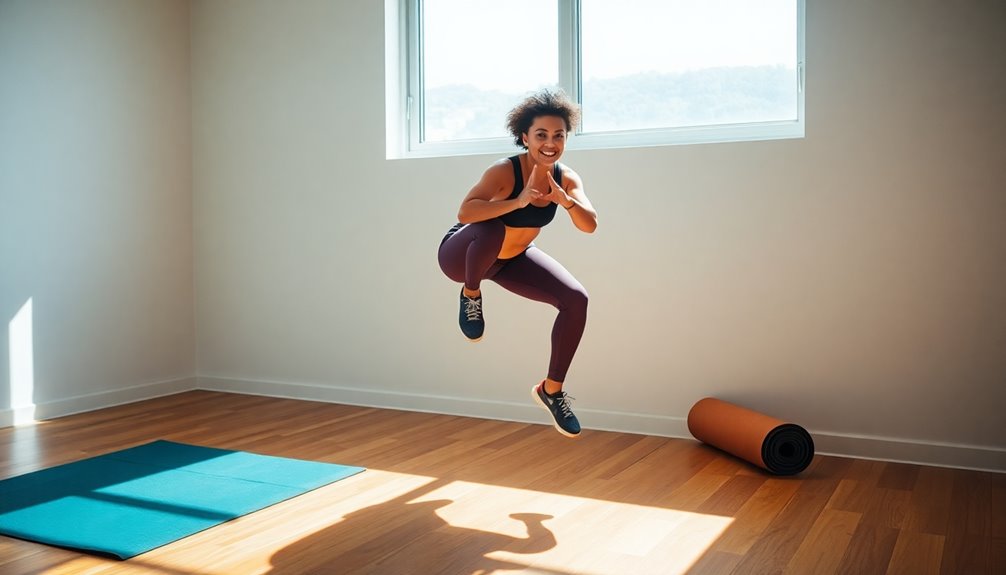
High-Intensity Interval Training, or HIIT, is a workout strategy that alternates short bursts of intense exercise with brief recovery periods. This method is perfect for you if you're looking to maximize your workout efficiency in a limited space. The key to HIIT is the HIIT intensity you bring to each interval. You push yourself hard during these bursts—think sprinting, jumping, or any high-energy movement that gets your heart racing. The idea is to give it your all for a short time, making the most of every second.
Now, let's talk about HIIT duration. Most HIIT workouts last anywhere from 10 to 30 minutes, making them incredibly manageable even if you've got a busy schedule. During this time, you'll alternate between high-intensity exercises and brief rest periods.
For instance, you might sprint for 30 seconds, then rest for 15 seconds, repeating this cycle multiple times. This structure not only keeps your heart rate up but also helps in burning calories more effectively than traditional workouts. Additionally, incorporating tools like mini bands can enhance your HIIT routine by providing resistance and targeting specific muscle groups.
One of the best parts about HIIT is that you don't need a lot of space or equipment. You can do it right in your living room or backyard. So, whether you're a fitness newbie or a seasoned pro, you'll find that HIIT offers a sense of community and belonging as you challenge yourself and others to exceed their limits. Engage fully, and enjoy the journey!
Benefits of HIIT in Small Spaces
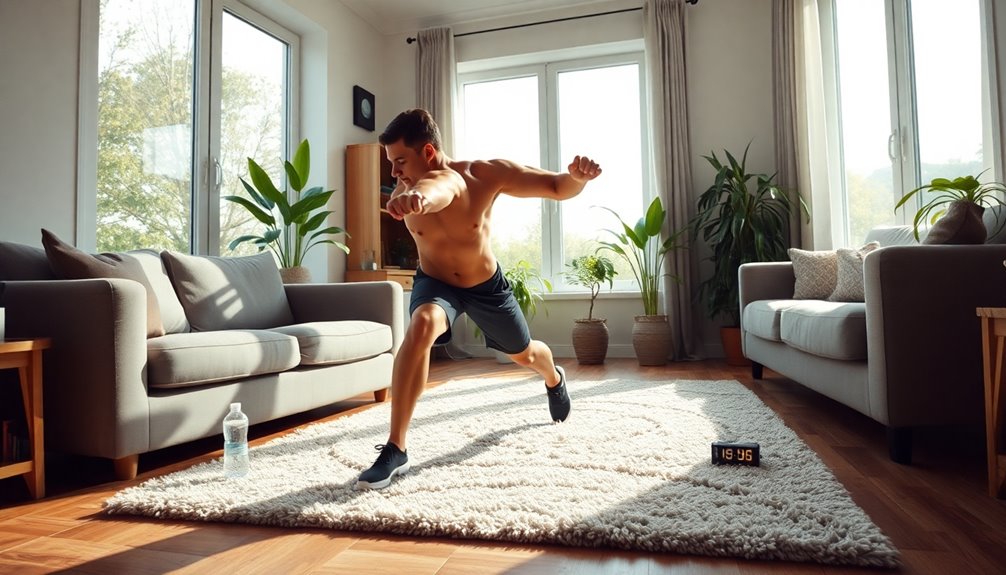
You'll find numerous benefits to practicing HIIT in small areas, making it an ideal workout choice for anyone with limited room. First off, space constraints shouldn't hold you back from achieving your fitness goals. HIIT workouts are designed to be intense and efficient, allowing you to maximize your time and effort, even in a confined area. You can easily perform exercises like burpees, jumping jacks, or mountain climbers without needing a lot of floor space.
Moreover, the health benefits of HIIT are substantial. Studies show that this type of training can improve cardiovascular health, increase muscle strength, and boost your metabolism. You'll enjoy these benefits without needing fancy equipment or a large gym. This makes HIIT not just accessible, but also inclusive. Whether you're in a small apartment, a dorm room, or your living room, you can participate in a workout that fits your lifestyle.
Additionally, HIIT fosters a sense of community. You can easily connect with others who share similar goals and challenges, whether through online groups or local meet-ups. Everyone's managing space limitations together, and that shared experience can be incredibly motivating. By embracing HIIT, you'll become part of a supportive network that encourages each other to push through barriers.
Incorporating glute-specific movements into your HIIT routine can enhance overall performance and target key muscle groups effectively.
In short, HIIT in small areas offers a blend of convenience and health benefits that can transform your fitness journey, making it a perfect fit for anyone looking to stay active and connected.
Preparing Your Workout Area
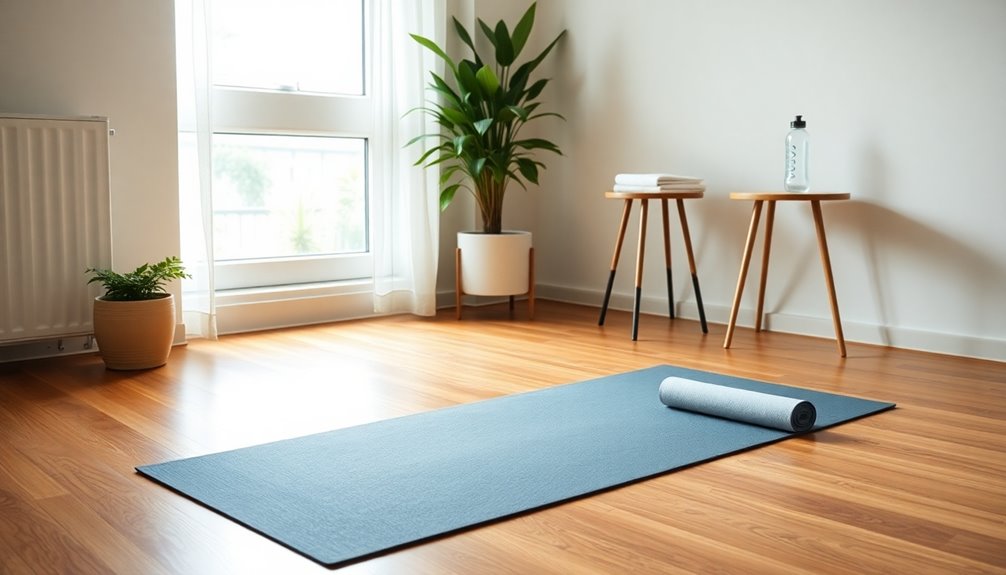
Before diving into your HIIT workout, it's vital to arrange your space to ensure a safe and efficient session. Start by finding a spot where you can move freely. Clear away any furniture or obstacles that could cause you to trip or get injured. A tidy area not only helps prevent accidents but also creates a more welcoming environment for your workout.
Next, consider the atmosphere of your workout area. Choosing workout music can greatly enhance your motivation and keep your energy levels high. Whether you prefer upbeat pop, intense electronic beats, or something calming, pick a playlist that resonates with you. If you're unsure where to start, explore popular HIIT playlists on streaming platforms for inspiration.
Once your music is set, it's time to focus on timing. Setting a timer for intervals is essential for HIIT workouts, as it helps you stay on track and maintain your intensity. You can use a phone app or a kitchen timer to manage your work and rest periods. Implementing effective core training strategies can also help improve your overall performance during HIIT sessions by enhancing core strength(#).
The typical format is 20 seconds of intense work followed by 10 seconds of rest, but feel free to adjust the intervals to suit your fitness level.
Warm-Up Exercises to Start
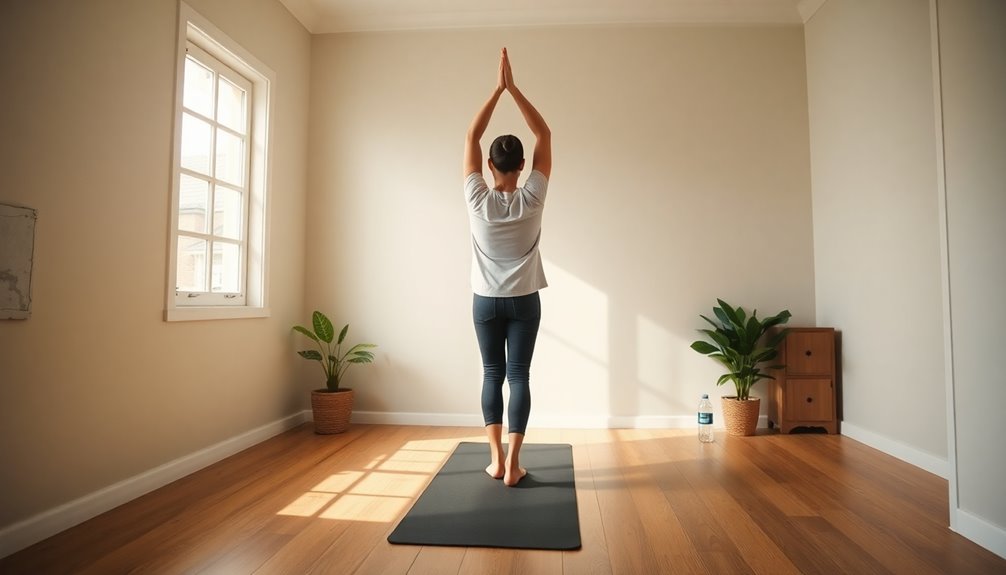
With your workout area set up and the right music pumping, it's time to get your body ready for action. Before diving into your HIIT session, warming up is vital to prevent injuries and enhance your performance. Start with some dynamic stretches to get your muscles activated. Think leg swings, arm circles, and torso twists. These movements increase blood flow and prepare your joints for the intensity ahead. Aim for 5-10 minutes of dynamic stretching to make sure your body is primed.
Next, incorporate mobility drills into your warm-up routine. These drills help improve your range of motion and activate muscle groups you'll be using during your HIIT workout. For instance, consider doing hip openers, ankle rolls, and shoulder mobility exercises.
You can even try a few deep lunges with a twist to engage your core while stretching your legs.
As you're going through these movements, focus on your breathing. Inhale deeply as you stretch, and exhale as you shift into the next movement. This not only enhances your warm-up but also sets a positive tone for your workout. Remember, you're part of a community that values fitness and progress. By taking these necessary steps to warm up, you're showing dedication to your health and well-being.
Bodyweight HIIT Exercises
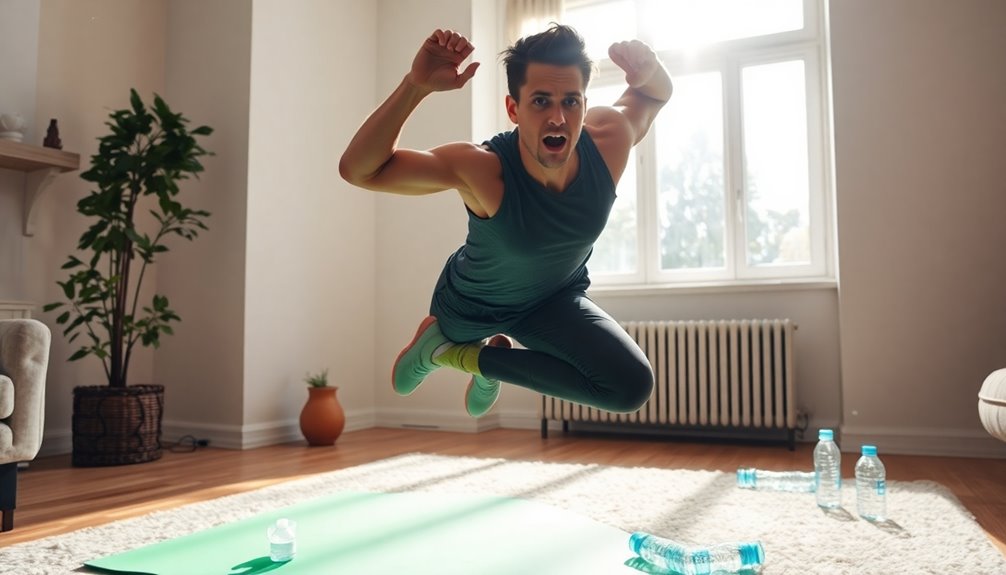
Bodyweight HIIT exercises pack a powerful punch when it comes to maximizing your workout in a small space. You don't need fancy equipment or a large area to break a sweat and feel accomplished. By incorporating various HIIT workout variations, you can tailor your routine to fit your fitness level and preferences. Whether you're a beginner or a seasoned athlete, you can choose from different HIIT intensity levels to challenge yourself.
Here's a quick guide to some effective bodyweight HIIT exercises you can try:
| Exercise | Description | Suggested Duration |
|---|---|---|
| Jumping Jacks | Full-body cardio move | 30 seconds |
| Push-Ups | Upper body strength builder | 30 seconds |
| Squat Jumps | Lower body powerhouse | 30 seconds |
Feel free to mix and match these exercises to create your own circuit. Start with a 30-second burst of each, followed by 15 seconds of rest. You can repeat this cycle for 15-20 minutes. Adjust the intensity by increasing the speed of your movements or reducing rest time as you become more comfortable. Additionally, consider incorporating exercise recommendations from various sources to keep your workouts fresh and engaging.
Sample HIIT Workouts
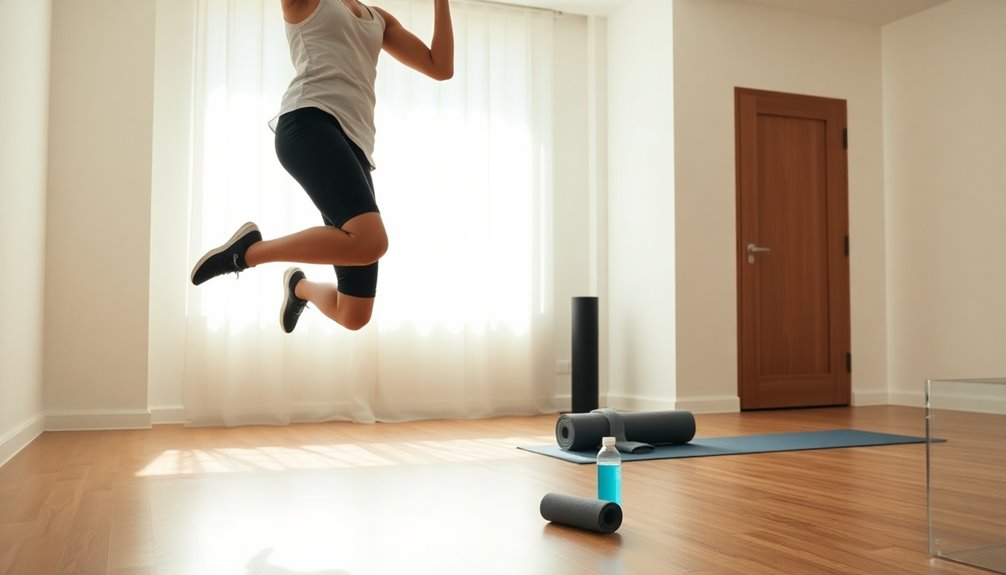
Creating effective HIIT workouts in small spaces is easier than you might think! You don't need a gym to get your heart pumping and muscles burning. Here's a sample HIIT circuit you can try right in your living room.
Start with a quick warm-up—just a few jumping jacks or high knees will do.
Then, begin your HIIT circuit. For this workout, you'll perform each exercise for 40 seconds, followed by a 20-second rest. Repeat the circuit three times for a solid session.
- Squats: Stand tall, feet shoulder-width apart, and lower your body as if sitting in a chair.
- Push-ups: Keep your body straight and lower down to the ground, then push back up.
- Burpees: From standing, drop into a squat, kick your feet back, return to squat, and jump up.
- Mountain Climbers: In a plank position, alternate bringing your knees to your chest quickly.
For a more intense workout, you could also try Tabata training. This method involves 20 seconds of maximum effort followed by 10 seconds of rest, repeated for eight rounds. Choose exercises like high knees or plank jacks to keep your heart rate high.
Incorporating a nutritious meal plan, such as The Smoothie Diet, can further enhance your fitness results and overall well-being.
Modifying Exercises for Limited Space
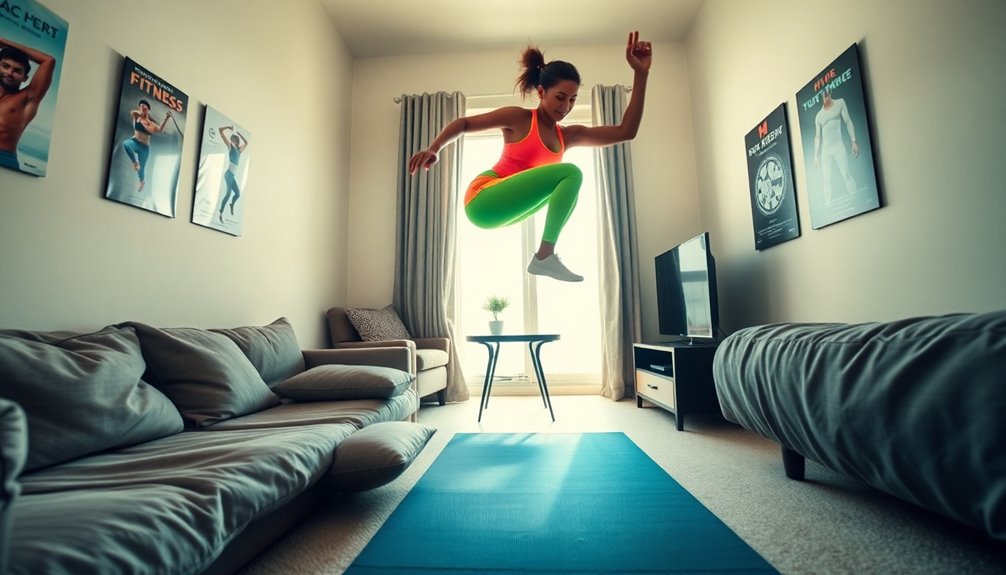
Finding ways to modify exercises for limited space can make your HIIT workouts more effective and enjoyable. You don't need a sprawling gym to get your heart pumping; with a few creative variations, you can transform almost any exercise to fit your environment.
For instance, bodyweight exercises like squats and lunges can be adjusted to stay within a smaller footprint. Instead of traditional jumping jacks, try standing jacks where you simply step side to side while raising your arms. This keeps you active without needing much room. Push-ups can also be modified; perform them against a wall or on your knees to save space and still get a solid workout.
Incorporating core exercises is another great way to maximize your small area. Planks can be performed on the floor or even on a sturdy surface like a countertop, allowing you to engage your core without taking up too much room.
Consider using space-saving solutions like stacking a few yoga blocks or a sturdy chair for modified movements. You can even get creative with your surroundings—use your couch for tricep dips or your stairs for step-ups, all while keeping your workout dynamic and engaging. Additionally, maintaining a healthy lifestyle through early detection and intervention can further enhance your fitness journey, especially for those managing chronic conditions.
With these modifications, you can stay committed to your HIIT routine, no matter how limited your space might be. Embrace the challenge, and remember that every bit of movement counts toward your fitness goals!
Cooling Down After HIIT

Cooling off after a HIIT session is just as crucial as the workout itself. You've pushed your limits, and now it's time to assist your body shift back to a resting state. Cooling off effectively can prevent injury and reduce muscle soreness, making it a vital part of your routine.
Start with some gentle stretching routines that target the muscles you've just worked. Stretching helps to release tension and enhances flexibility. Consider focusing on your hamstrings, quadriceps, and shoulders. Hold each stretch for about 15-30 seconds, and remember to breathe through it. This isn't just about flexibility; it's also about allowing your heart rate to gradually decrease.
Integrating breathing techniques into your cool-off can further boost your recovery. Take deep, controlled breaths as you stretch. Inhale through your nose for a count of four, hold for a moment, and then exhale through your mouth for a count of six. This practice not only relaxes your mind but also assists in oxygenating your muscles, aiding them in recovering more effectively.
Tips for Staying Motivated
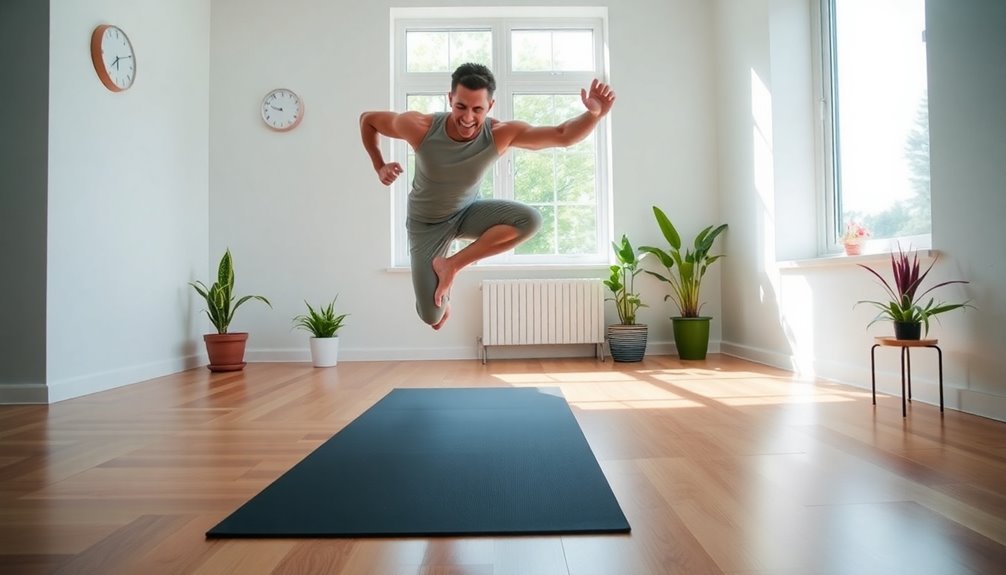
Staying motivated during your HIIT workouts, especially in small spaces without equipment, can be a challenge; however, setting clear goals can make all the difference. Start by defining what you want to achieve—whether it's improving your endurance, losing weight, or simply feeling more energized. Break these larger goals into smaller, achievable milestones. Celebrate each victory, no matter how minor; this reinforces your progress and keeps you engaged.
Additionally, consider finding an accountability partner. This could be a friend, family member, or even someone from an online fitness community. Sharing your goals with someone else not only holds you accountable but also fosters a sense of belonging. You're in this together, and having someone to share your struggles and successes with can be incredibly motivating. Schedule regular check-ins to discuss your progress and encourage each other.
To keep things fresh, mix up your workouts and challenge yourself. Try new exercises or increase your workout duration incrementally. This variety will keep boredom at bay and make your sessions feel less routine. Incorporating exercise and workouts tailored to individual goals can also enhance your motivation and results.
Incorporating HIIT Into Your Routine
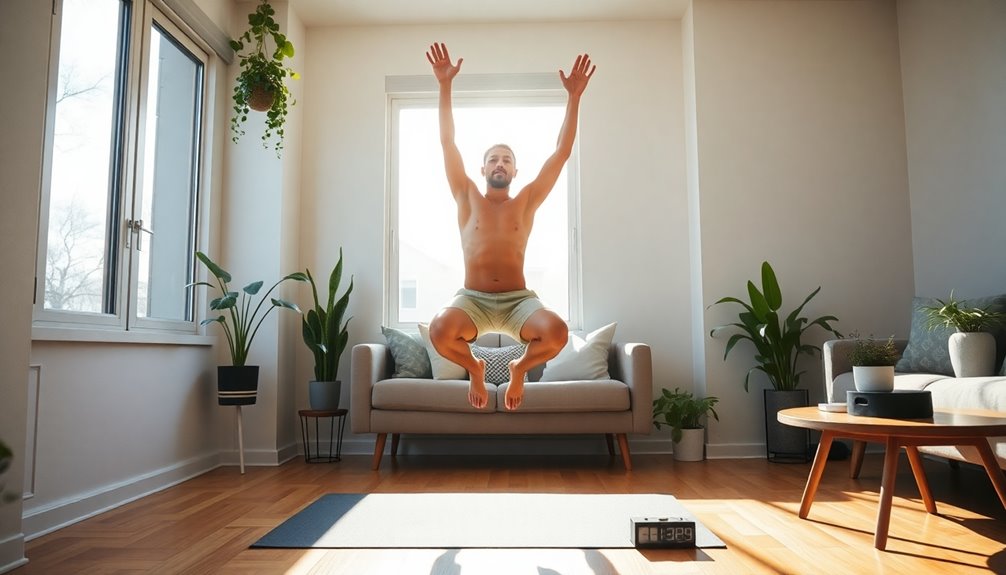
Incorporating HIIT into your routine can transform your workout experience, making it more efficient and exciting. You'll discover that short bursts of intense exercise can fit perfectly into your busy schedule. By integrating HIIT progressions and variations, you'll keep your workouts fresh and engaging.
One way to start is by planning your week to include HIIT sessions. You could dedicate two to three days for HIIT, interspersed with your regular workouts. Here's a simple table to help you visualize how to mix it up:
| Day | HIIT Focus |
|---|---|
| Monday | Full-Body HIIT |
| Wednesday | Lower Body HIIT Alternatives |
| Friday | Core & Cardio HIIT |
| Saturday | HIIT Progressions |
| Sunday | Active Recovery |
When you choose different HIIT alternatives, such as jump squats or burpees, you challenge your body in new ways. This not only boosts your fitness levels but also keeps you motivated. It's crucial to listen to your body and adjust the intensity as needed, ensuring you progress safely. Additionally, incorporating mind/body exercises into your routine can help manage your blood pressure effectively.
Frequently Asked Questions
Can I Do HIIT Every Day in a Small Space?
You can do HIIT every day in a small space, but it's important to take into account frequency limits. Overdoing it can lead to burnout or injuries, so mix in lighter workouts or rest days for injury prevention. Listen to your body and adjust your routine as needed.
Staying connected with a community can also help keep you motivated and accountable while ensuring you're not pushing yourself too hard. Balance is key!
What if I Have Mobility Issues?
If you have mobility issues, you can still enjoy effective workouts! Seated modifications and chair exercises are fantastic options. You can incorporate movements like seated leg lifts, arm raises, and even seated marches to get your heart rate up. These modifications keep you active while accommodating your needs, ensuring you feel included and empowered.
Don't hesitate to explore different exercises that suit your abilities; staying active is all about finding what works best for you!
How Long Should Each HIIT Session Last?
For best duration, aim for HIIT sessions lasting 20 to 30 minutes. This timeframe allows you to maximize benefits while minimizing risks of overexertion.
Incorporate effective intervals, like 30 seconds of intense work followed by 30 seconds of rest. This approach keeps your heart rate up and boosts calorie burn.
Can I Combine HIIT With Other Workout Styles?
Can you really enhance your workouts by combining HIIT with other styles? Absolutely! Pairing HIIT with yoga can boost flexibility and mindfulness, while incorporating Pilates adds core strength and stability. You'll find that mixing these approaches keeps your routine fresh and engaging.
Just remember to listen to your body and balance intensity with recovery. By blending these workouts, you not only challenge yourself but also create a sense of community and belonging in your fitness journey.
What Should I Eat Before and After HIIT?
Before your HIIT session, grab some pre-workout snacks like a banana or a handful of nuts to fuel your energy. Aim to eat these about 30 minutes prior, so your body has time to digest.
After your workout, focus on post-workout meals that include protein and carbs, like a smoothie or chicken with rice, to replenish nutrients and aid recovery. Timing's key, so don't skip these essential steps for peak performance!
Conclusion
Incorporating HIIT into your routine, even in small spaces, can transform your fitness journey. Picture yourself maximizing every inch of your living area, turning it into a dynamic workout zone. With bodyweight exercises, creative modifications, and a bit of motivation, you can achieve effective, efficient workouts anytime. Remember, it's not about the size of your space but how you utilize it. So, embrace the challenge, get moving, and enjoy the benefits of high-intensity training right at home!



